Crank J. Free and Moving Boundary Problems
Подождите немного. Документ загружается.

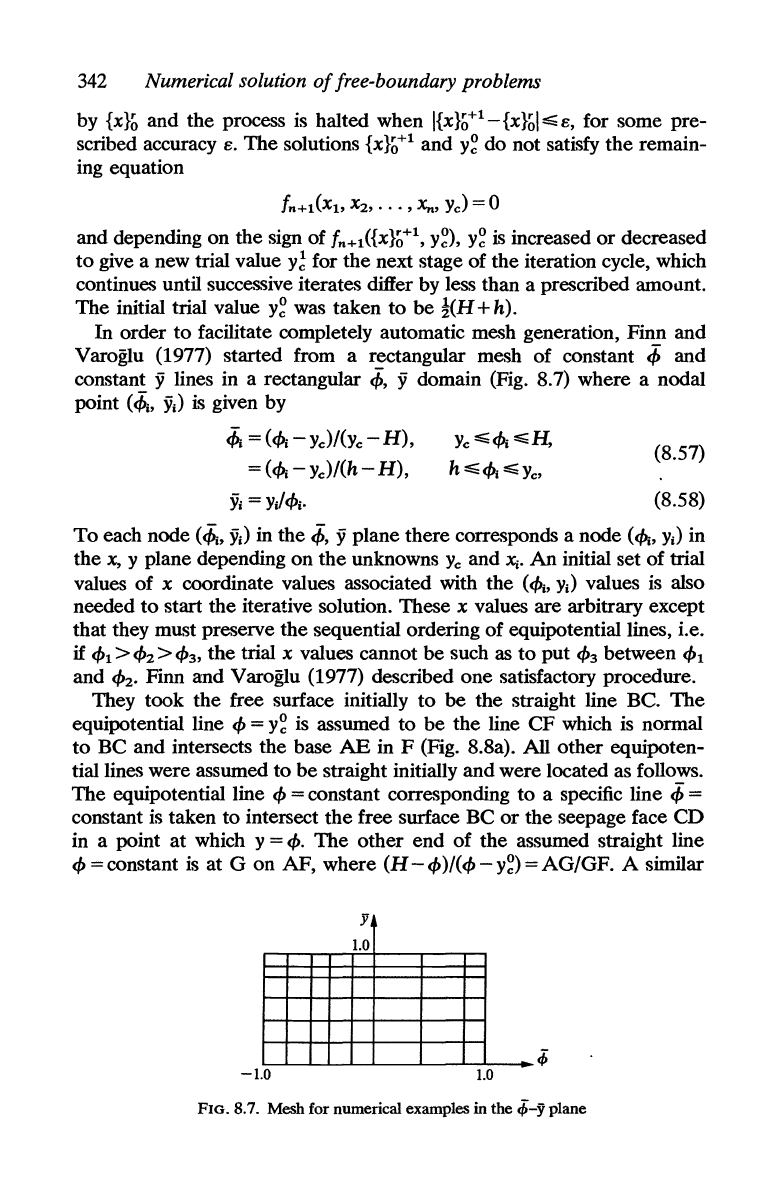
342
Numerical solution
of
free-boundary problems
by
{x}o
and
the
process is halted when
I{X}o+1_{X}ol~B,
for some pre-
scribed accuracy
B.
The solutions
{x}o+1
and
y~
do
not sati'lfy
the
remain-
ing equation
fn+1(X1,
X2,
...
,Xn,
Yc)
= 0
and depending on the sign of
fn+1({X}0+1,
y~),
y~
i'l
increased
or
decreased
to
give a new trial value y
~
for the next stage of the iteration cycle, which
continues until successive iterates differ by
les.'I
than a prescribed amount.
The initial trial value
y~
was taken
to
be
!(H
+ h).
In order
to
facilitate completely automatic me'lh generation, Finn and
VarogIu (1977) started from a rectangular me'lh of constant
4>
and
constant
y lines in a rectangular
4>,
y domain (Fig. 8.7) where a nodal
point
(~,
yJ
is
given by
~
=
(<I>I
-
Yc)/(Yc
-
H),
=
(</>;
- yc)/(h -
H),
YI
=
yJ<I>I'
Yc
~</>;
~H,
h
~</>;
~yc'
(8.57)
(8.58)
To
each node
(~,
Yi)
in the
4>,
y plane there corre'lponds a node
(</>;,
yJ
in
the
x,
y plane depending on
the
unknowns
Yc
and
x;.
An
initial set of trial
values of
x coordinate value'l associated with the
(<1>1,
yJ
values is also
needed
to
start the iterative solution. These x values are arbitrary except
that they must preserve
the
sequential ordering of equipotential lines, i.e.
if
<1>1>
<1>2
>
<1>3,
the
trial x values cannot
be
such as
to
put
<1>3
between
<1>1
and
<1>2'
Finn and Varoglu (1977) de'lcribed one satisfactory procedure.
They took
the
free surface initially
to
be
the straight line BC.
The
equipotential line
<I>
=
y~
is
assumed to be the line
CF
which is normal
to
BC and intersects the base
AE
in F (Fig. 8.8a). All other equipoten-
tialline'l were assumed
to
be
straight initially and were located as follows.
The
equipotential line
<I>
= constant corre'lponding
to
a specific line
4>
=
constant is taken to intersect
the
free surface BC
or
the seepage face
CD
in a point at which y =
<1>.
The
other
end of the assumed straight line
<I>
= constant
is
at G on AF, where
(H
-
<I>
)/(<1>
-
y~)
= AG/GF. A similar
jl
1.0
-1.0
1.0
FIG. 8.7. Mesh for numerical examples
in
the
,"b-y
plane
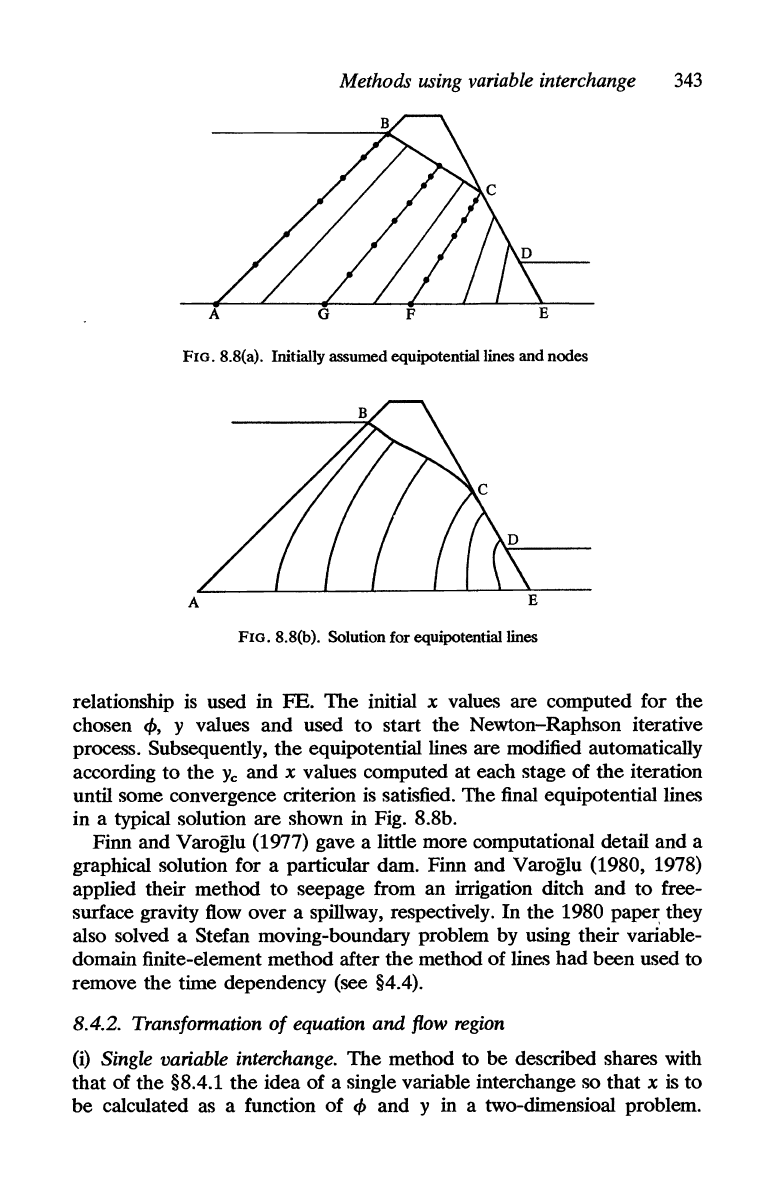
Methods using variable interchange
343
A
FIG. 8.8(a). Initially assumed equipotential lines and nodes
A
E
FIG. 8.8(b). Solution for equipotential lines
relationship
is
used in
FE.
The
initial x values are computed for the
chosen
q"
y values and used
to
start the Newton-Raphson iterative
process. Subsequently,
the
equipotential lines are modified automatically
according
to
the
Yc
and x values computed at each stage of
the
iteration
until some convergence criterion
is
satisfied. The final equipotential lines
in a typical solution are shown in Fig. 8.8b.
Finn and Varoglu (1977) gave a little more computational detail and a
graphical solution for a particular dam. Finn and Varoglu (1980, 1978)
applied their method
to
seepage from an irrigation ditch and
to
free-
surface gravity flow over a spillway, respectively. In the 1980 paper they
also solved a Stefan moving-boundary problem by using their varlable-
domain finite-element method after
the
method of line'! had been used to
remove
the
time dependency (see §4.4).
8.4.2. Transformation
of
equation
and
flow region
(i)
Single variable interchange. The method to be described shares with
that of the §8.4.1
the
idea of a single variable interchange so that x is
to
be calculated as a function
of
q,
and y in a two-dimensioal problem.
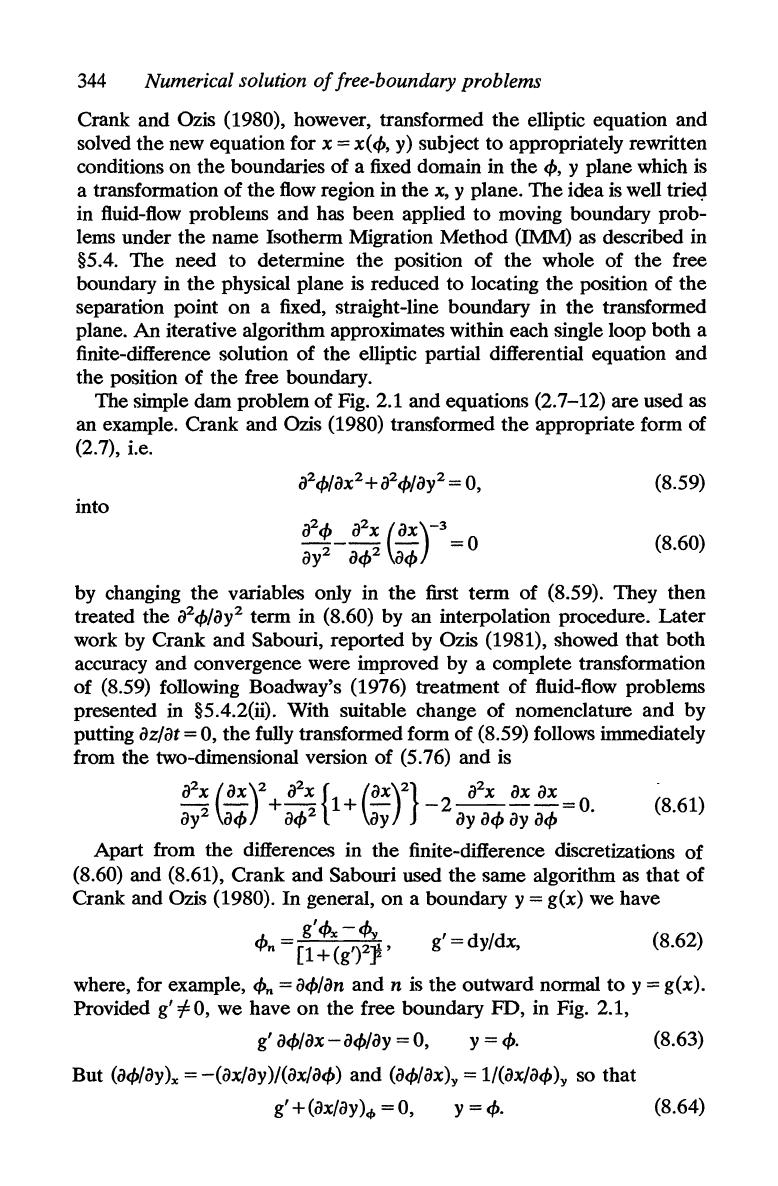
344
Numerical solution
of
free-boundary problems
Crank and Ozis (1980), however, transformed the elliptic equation and
solved
the
new equation for x = x(q" y) subject
to
appropriately rewritten
conditions
on
the
boundaries of a fixed domain in the
q"
y plane which is
a transformation
of
the
flow
region in the
x,
y plane.
The
idea is well trie4
in fluid-flow problems and has been applied to moving boundary prob-
lems under the name Isotherm Migration Method (IMM) as described in
§5.4.
The
need to determine the position
of
the whole
of
the free
boundary in
the
physical plane is reduced to locating the position of
the
separation point
on
a fixed, straight-line boundary in
the
transformed
plane.
An
iterative algorithm approximates within each single loop both a
finite-difference solution
of
the elliptic partial differential equation and
the position
of
the
free boundary.
The simple
dam
problem
of
Fig. 2.1 and equations (2.7-12) are used as
an example. Crank and Ozis (1980) transformed
the
appropriate form
of
(2.7), i.e.
into
aZq,
_
aZx
(ax)-3
=0
ayZ
aq,z
aq,
(8.59)
(8.60)
by changing
the
variables only in
the
first
term
of (8.59). They then
treated the
;Pq,/ayz
term in (8.60) by
an
interpolation procedure.
Later
work by Crank
and
Sabouri, reported by Ozis (1981), showed that both
accuracy and convergence were improved by a complete transformation
of
(8.59) following Boadway's (1976) treatment
of
fluid-flow problems
presented in
§5.4.2(ii). With suitable change
of
nomenclature and by
putting
az/at
= 0,
the
fully transformed form
of
(8.59) follows immediately
from the two-dimensional version
of
(5.76) and is
aZx
(ax)Z +
aZx
{1 +
(ax)Z}
_ 2
aZx
ax
ax
=
O.
(8.61)
ayZ
aq,
aq,z
ay
ay
aq,
ay
aq,
Apart from the differences in the finite-difference discretizations
of
(8.60) and (8.61), Crank and Sabouri used
the
same algorithm as
that
of
Crank and Ozis (1980).
In
general,
on
a boundary y = g(x) we have
g'<bx-~
q,n
= [1 +
(g')Z,
' g' = dy/dx, (8.62)
where, for example,
<bn
=
aq,/an
and n is
the
outward normal
to
y = g(x).
Provided
g'=j=O,
we have
on
the free boundary
PD,
in Fig. 2.1,
g'
aq,/ax-aq,/ay
=0,
y =
q,.
(8.63)
But
(aq,/aY)x=-(ax/ay)/(ax/a</J)
and
(aq,/ax)y=l/(ax/aq,)y
so that
g' +
(ax/aY)<I>
= 0, y =
q,.
(8.64)
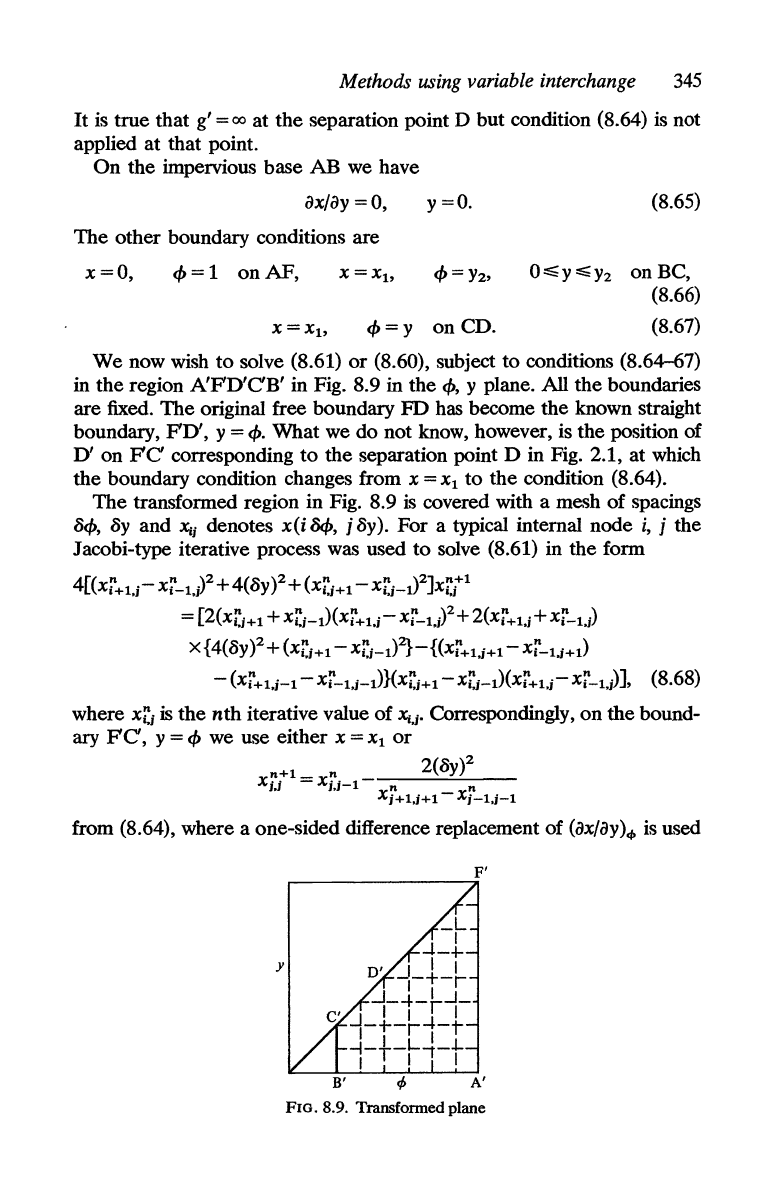
Methods using variable interchange
345
It
is
true
that g' =
00
at the separation point D but condition (8.64)
is
not
applied
at
that point.
On
the impervious base
AB
we have
aX/ay
=0,
y=O.
(8.65)
The
other boundary conditions are
x=O,
</>
= 1
onAF,
X=Xh
</>
=
Y2'
0~Y~Y2
onBC,
(8.66)
X=Xh
</>=y
on CD.
(8.67)
We
now wish
to
solve (8.61)
or
(8.60), subject
to
conditions (8.64-67)
in
the
region
A'FD'CB'
in Fig. 8.9 in the
</>,
y plane. All the boundaries
are fixed.
The
original free boundary
FD
has become the known straight
boundary,
FD',
y =
</>.
What we do not know, however, is the position of
D'
on
FC
corresponding
to
the separation point D in Fig. 2.1, at which
the
boundary condition changes from x = Xl
to
the
condition (8.64).
The
transformed region in Fig. 8.9
is
covered with a
meo;h
of spacings
8</>,
8y
and X;j
denote.o;
x(i8</>,
j8y).
For a typical internal node
i,
j the
Jacobi-type iterative process
wao;
used
to
solve (8.61)
in
the form
4[(X~I,j-
xr-l,j?+4(8y)2+
(x~j+1
-
XY_I)2]x~r
= [2(XY+I +
XY-I)(X~I,j-
Xr-l,j?+
2(X~+I,j+
X~-IJ)
x {4(8y)2 +
(X~j+l
-
X~j-I?}-{(X~+1J+I
- Xr-IJ+I)
-
(X~+1,j-1
-
Xr-I,j-I)}(X~j+1
-
X~j-I)(X~I,j-
Xr-l,j)],
(8.68)
where
X~j
is
the
nth
iterative value of X;J. Correspondingly,
on
the bound-
ary
FC,
y =
</>
we use either X = Xl
or
n+l_
n 2(8y)2
Xj,j
- Xj,j-l - n n
Xj+l,/+l -
Xj-IJ-I
from (8.64), where a one-sided difference replacement of
(iJx/iJY)<t>
is
used
FIG. 8.9. Transfonned plane
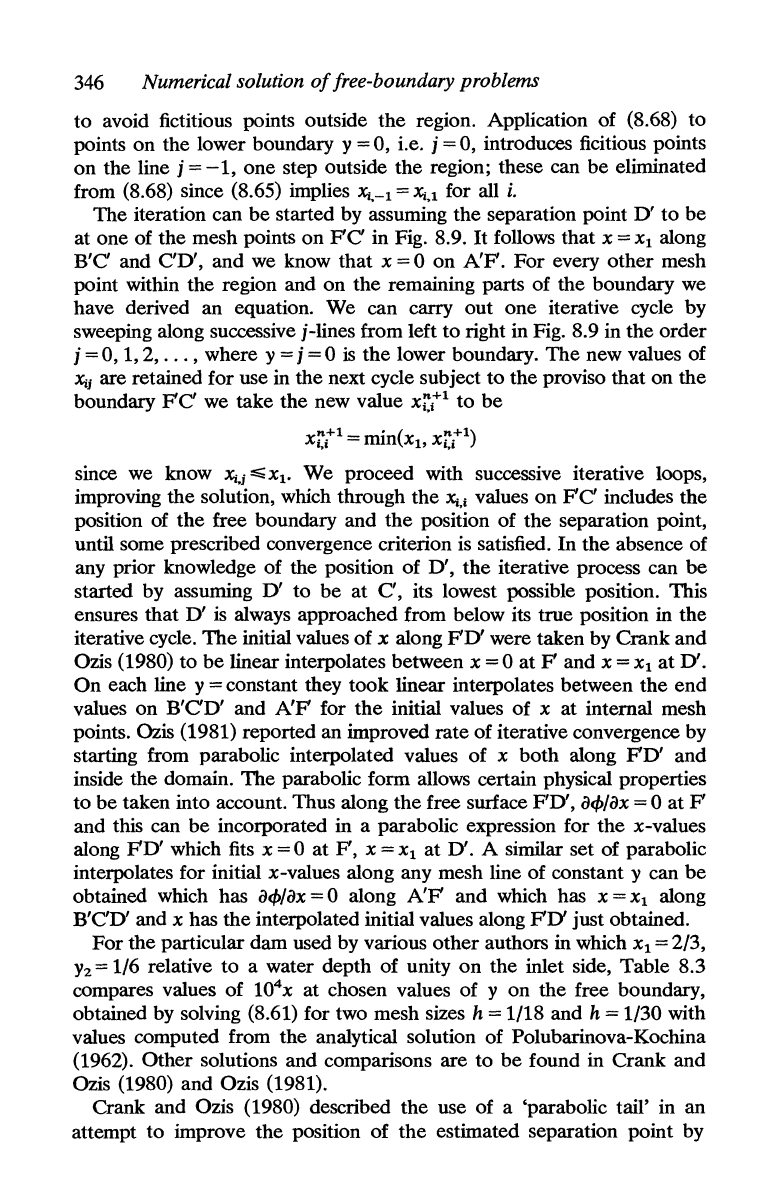
346
Numerical solution
of
free-boundary problems
to
avoid fictitious points outside
the
region. Application
of
(8.68)
to
points
on
the lower boundary y = 0, i.e. j = 0, introduces ficitious points
on
the line j =
-1,
one
step outside
the
region; these can
be
eliminated
from (8.68) since (8.65) implies
Xi,-l =
Xi,l
for all
i.
The
iteration can
be
started by assuming
the
separation point
D'
to
be
at one of
the
mesh points
on
FC
in Fig. 8.9.
It
follows that x =
Xl
along
B'C
and C'D', and we know
that
X = 0
on
A'F.
For
every
other
mesh
point within the region and
on
the
remaining parts
of
the boundary we
have derived an equation. We can carry
out
one
iterative cycle
by
sweeping along successive j-lines from left
to
right in Fig. 8.9 in
the
order
j =
0,1,2,
...
, where y = j = 0
is
the
lower boundary.
The
new values of
Xij
are retained for use in the next cycle subject
to
the
proviso
that
on
the
boundary
FC
we take
the
new value
x~tl
to
be
since we know
Xi.i
:S;;Xl'
We
proceed with successive iterative loops,
improving
the
solution, which through
the
Xi,i
values
on
FC
includes
the
position of
the
free boundary and
the
position of
the
separation point,
until some prescribed convergence criterion is satisfied.
In
the
absence of
any prior knowledge of the position of
D',
the
iterative process can
be
started by assuming
D'
to
be
at
C,
its lowest possible position. This
ensures
that
D'
is
always approached from below its true position in
the
iterative cycle.
The
initial values
of
x along
FD'
were taken by
Crank
and
Ozis (1980)
to
be
linear interpolates between x = 0
at
F and x =
Xl
at
D'.
On
each line y = constant they
took
linear interpolates between
the
end
values
on
B'CD'
and
NF
for
the
initial values of x
at
internal mesh
points.
Ozis (1981) reported an improved
rate
of iterative convergence by
starting from parabolic interpolated values
of
x
both
along
FD'
and
inside the domain.
The
parabolic form allows certain physical properties
to
be
taken into account. Thus along
the
free surlace
FD',
iJrJ>/ax
= 0
at
F
and this can
be
incorporated in a parabolic expression for
the
x-values
along
FD'
which fits x = 0
at
F,
x =
Xl
at
D'.
A similar set of parabolic
interpolates for initial x-values along any mesh line of constant
y can
be
obtained which has
arJ>/ax
= 0 along
A'F
and
which has x =
Xl
along
B'CD'
and x has
the
interpolated initial values along
FD'
just obtained.
For
the particular
dam
used by various
other
authors in which
Xl
= 2/3,
Y2
= 1/6 relative
to
a water depth of unity
on
the
inlet side, Table 8.3
compares values
of
10
4
x
at
chosen values
of
y
on
the free boundary,
obtained by solving (8.61) for two mesh sizes
h = 1/18 and h = 1/30 with
values computed from the analytical solution of Polubarinova-Kochina
(1962).
Other
solutions and comparisons are
to
be
found in
Crank
and
Ozis (1980) and Ozis (1981).
Crank and Ozis (1980) described
the
use
of
a 'parabolic tail' in an
attempt
to
improve
the
position of
the
estimated separation point by
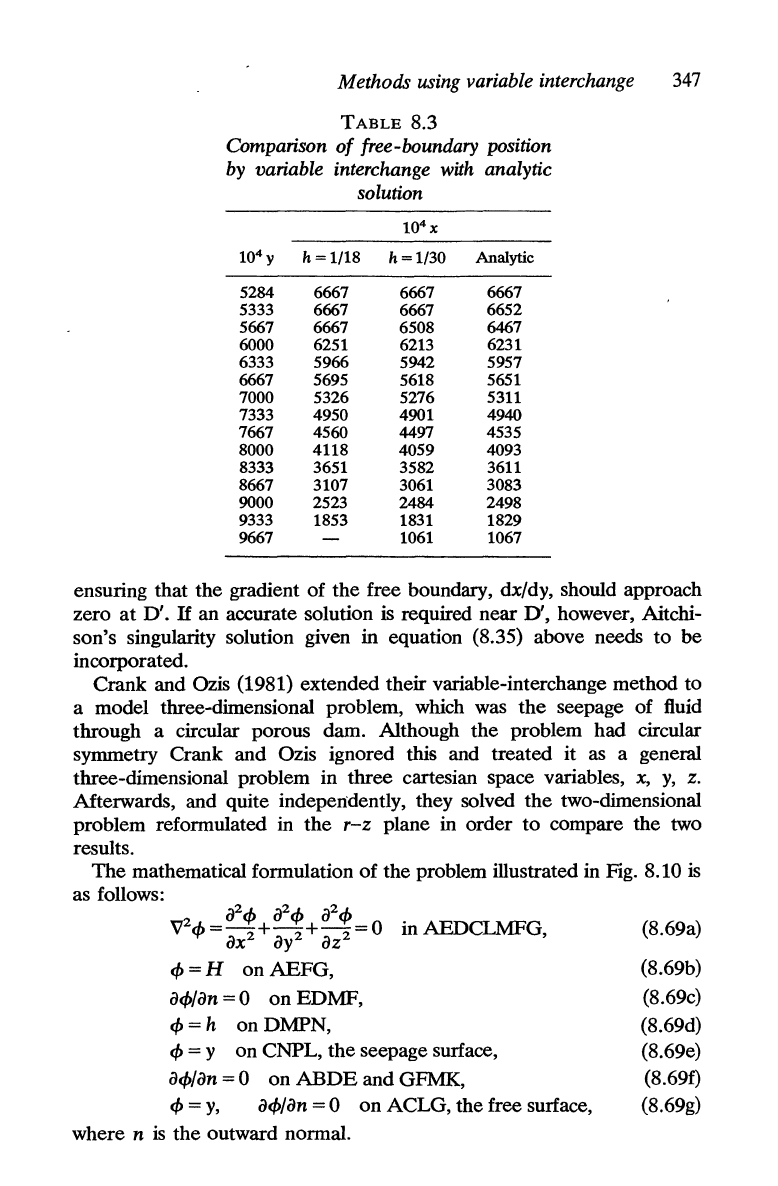
Methods using variable interchange
347
TABLE
S.3
Comparison
of
free-boundary position
by variable interchange with analytic
solution
10
4
X
104y
h=
1/18
h=1/30
Analytic
5284
6667
6667 6667
5333
6667
6667
6652
5667
6667
6508
6467
6000
6251
6213
6231
6333
5966
5942 5957
6667
5695
5618
5651
7000
5326 5276
5311
7333
4950
4901 4940
7667 4560
4497
4535
8000
4118 4059
4093
8333
3651
3582
3611
8667 3107
3061
3083
9000
2523
2484
2498
9333
1853
1831
1829
9667
1061
1067
ensuring that the gradient
of
the free boundary, dx/dy, should approach
zero
at
D'. H an accurate solution is required near D', however, Aitchi-
son's singularity solution given
in
equation (S.35) above needs
to
be
incorporated.
Crank and
Ozis (19S1) extended their variable-interchange method to
a model three-dimensional problem, which was
the
seepage of fluid
through a circular porous dam. Although the problem had circular
symmetry Crank and Ozis ignored this and treated it as a general
three-dimensional problem in three cartesian space variables,
x,
y,
z.
Afterwards, and quite independently, they solved the two-dimensional
problem reformulated in the
r-z
plane in order to compare the two
results.
The
mathematical formulation
of
the problem illustrated in Fig. S.10
is
as follows:
V
2
ef>
=
cief>
+
cief>
+
cief>
= 0 in AEDCLMFG,
iJx
2
iJy2
iJz2
ef>
=H
on AEFG,
iJcf>/iJn
= 0
on
EDMF,
ef>
= h on DMPN,
ef>
= y
On
CNPL, the seepage surface,
iJef>/dn
= 0 on
ABDE
and GFMK,
ef>
=
y,
iJef>/iJn
= 0
on
ACLG, the free surface,
where n
is
the outward normal.
(S.69a)
(S.69b)
(S.69c)
(S.69d)
(S.6ge)
(S.69f)
(S.69g)
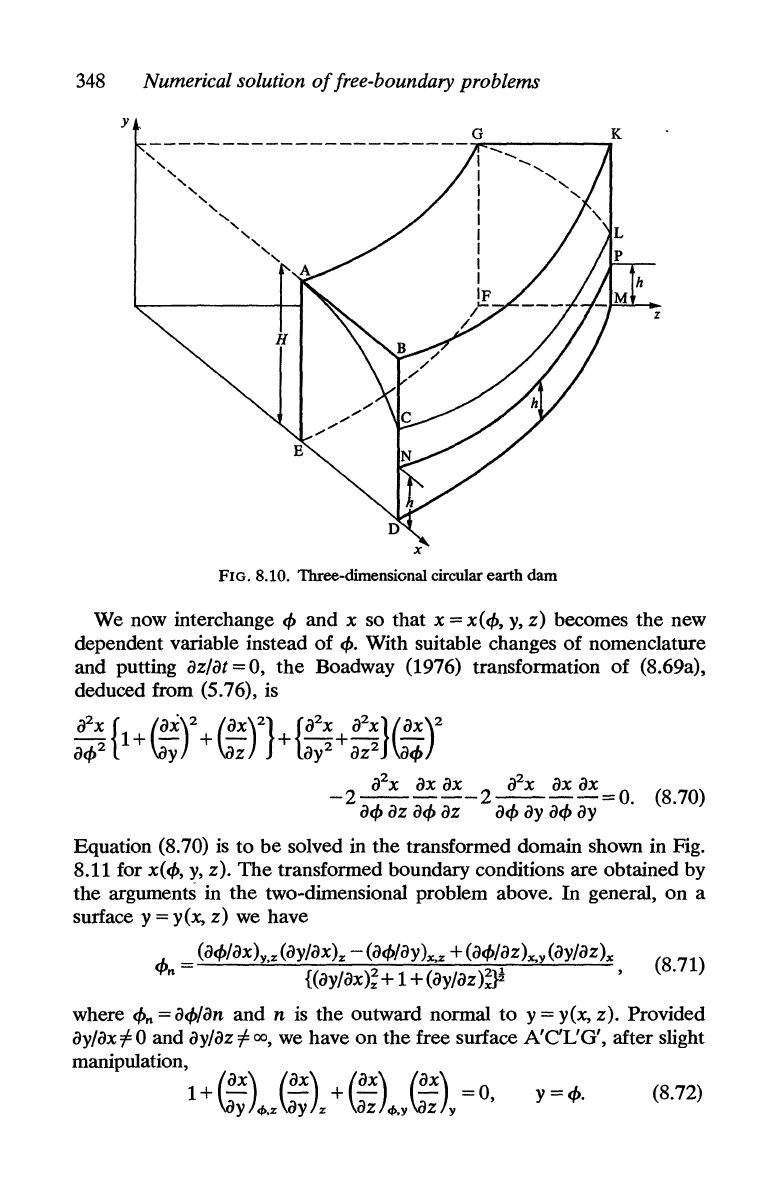
348
Numerical solution
of
free-boundary problems
y
x
FIG. 8.10. Three-dimensional circular earth dam
We
now interchange
q,
and
x so
that
x = x(q"
y,
z)
becomes
the
new
dependent variable instead
of
q,.
With suitable changes
of
nomenclature
and putting
iJz/iJt
= 0,
the
Boadway (1976) transformation
of
(8.69a),
deduced from (5.76), is
iJ
2
x
{1
+
{~i)2
+ (iJX)2}+ {iJ
2
X +
iJ
2
x}
(iJX)2
iJq,2
\ay
\az
iJy2
iJ
z
2
iJq,
_ 2
iJ
2
x
iJx iJx
_ 2
iJ
2
x
iJx iJx
=
O.
iJq,
iJz
iJq,
iJz
iJq,
iJy
iJq,
iJy
(8.70)
Equation (8.70) is
to
be
solved in
the
transformed domain shown
in
Fig.
8.11 for x(q"
y,
z).
The
transformed boundary conditions
are
obtained by
the
argumentS in
the
two-dimensional problem above.
In
general,
on
a
surface y = y(x,
z)
we have
q,
= (iJq,/iJx\'z(iJy/iJx)z -(iJq,/iJy)x.z +
(iJq,/iJz)x,y(iJy/iJz)x
(8.71)
n {(iJy/iJx);+ 1
+(iJy/iJz)~
,
where
q,n
=
iJq,/iJn
and
n is
the
outward normal
to
y = y(x, z). Provided
iJy/iJxf=O
and
iJy/iJzf=oo,
we have
on
the
free surface A'C'L'G', after slight
manipulation,
1 + (iJX) (iJX) + (iJX) (iJX) = 0 Y =
q,.
(8.72)
\ay
<I>.z
iJy
z
iJz
<I>.y
\az
y ,
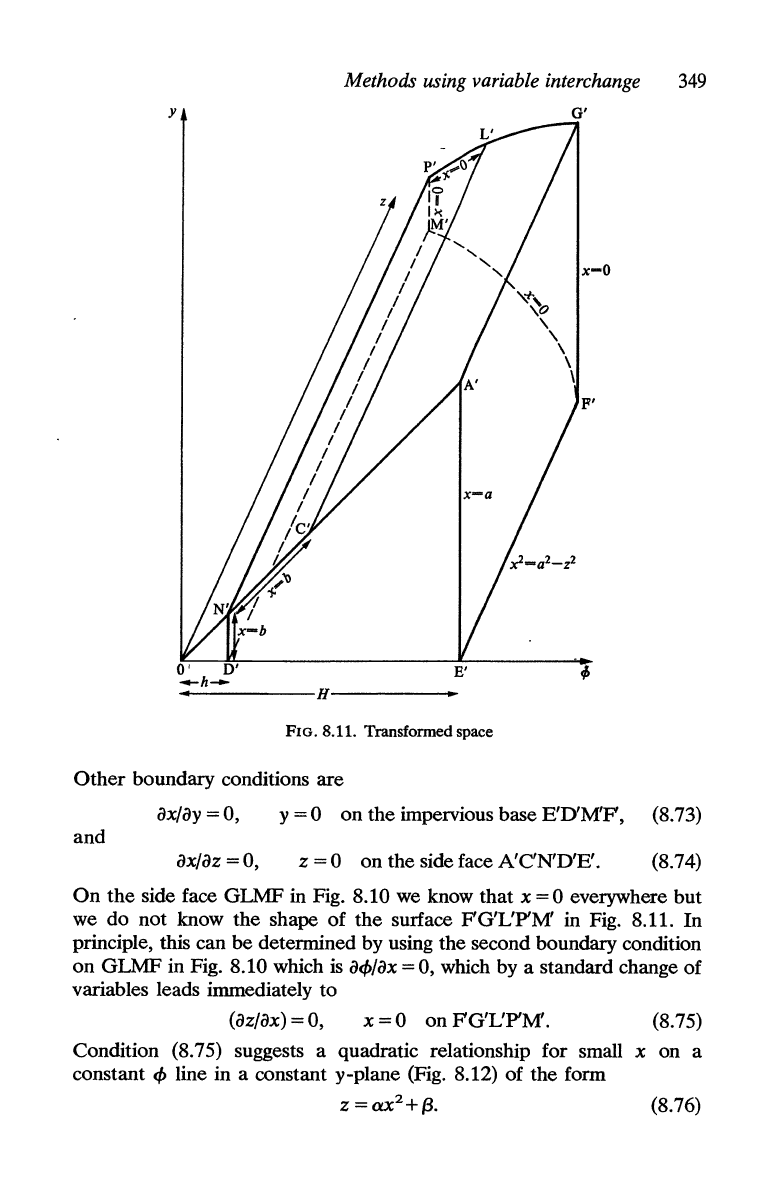
Methods using variable interchange
349
y
G'
~----------H----------·
FIG. 8.11. Transfonned space
Other
boundary conditions are
ax/ay
=0,
y
=0
on
the impervious base
E'D'M'P,
(8.73)
and
ax/az
=0,
z = 0
on
the side face
A'
C'N'D'E'.
(8.74)
On
the
side face GLMF in Fig. 8.10 we know
that
x = 0 everywhere but
we
do
not know the shape
of
the surface
FG'L'P'M
in Fig. 8.11.
In
principle, this can
be
determined by using the second boundary condition
on
GLMF
in Fig. 8.10 which
is
acb/ax
= 0, which by a standard change
of
variables leads immediately to
(az/ax)
=0,
x=O
onFG'L'P'M'.
(8.75)
Condition (8.75) suggests a quadratic relationship for small
x on a
constant
cb
line in a constant y-plane (Fig. 8.12) of the form
(8.76)
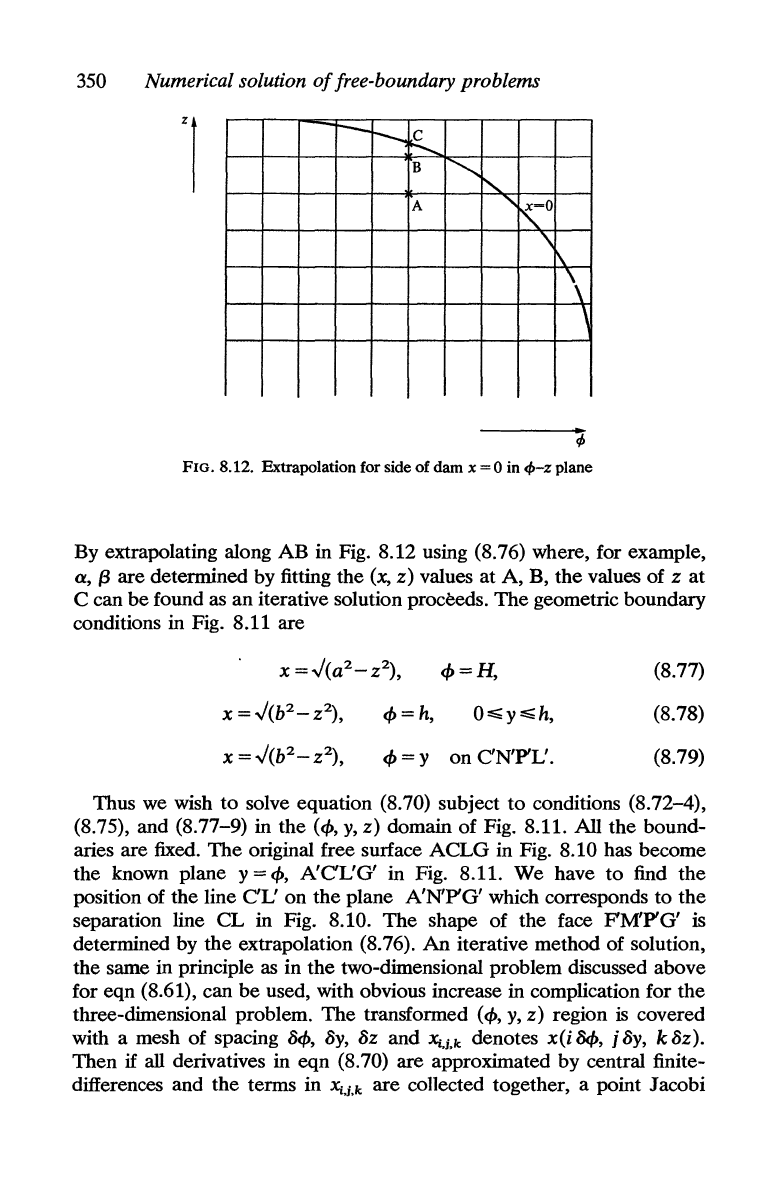
350
Numerical solution
of
free-boundary problems
-
r--
F----
B
~
'"
A
......
x-O
"-
\
\.
\
\
~
FIG.
8.12. Extrapolation for side of dam
x=O
in
cf>-z
plane
By extrapolating along
AB
in Fig. 8.12 using (8.76) where, for example,
a,
(3
are determined by fitting the
(x,
z)
values
at
A,
B,
the
values of z
at
C can
be
found as
an
iterative solution proceeds.
The
geometric boundary
conditions in Fig. 8.11 are
x =
.j(b
2
-
Z2),
X =
.j(b
2
-
Z2),
</>
=H,
</>
=
h,
</>
= y
on
CN'P'L'.
(8.77)
(8.78)
(8.79)
Thus we wish
to
solve equation (8.70) subject
to
conditions (8.72-4),
(8.75),
and (8.77-9) in
the
(</>,
y,
z) domain
of
Fig. 8.11. All
the
bound-
aries are fixed.
The
original free surface
ACLO
in Fig. 8.10 has become
the known plane
y =
</>,
A'CL'O'
in Fig. 8.11. We have
to
find
the
position of the line
CL'
on
the
plane
A'N'P'O'
which corresponds
to
the
separation line
CL
in Fig. 8.10.
The
shape
of
the face
FM'P'O'
is
determined by
the
extrapolation (8.76).
An
iterative method of solution,
the same in principle
as
in
the
two-dimensional problem discussed above
for eqn
(8.61), can
be
used, with obvious increase in complication for
the
three-dimensional problem.
The
transformed
(</>,
y,
z)
region is covered
with a mesh
of
spacing
&/>,
By,
Bz
and
X;,j,k
denotes
x(i
&/>,
j
By,
k Bz).
Then
if
all derivatives in
eqn
(8.70) are approximated by central finite-
differences and
the
terms in
X;,j,k
are collected together, a point Jacobi

Methods using variable interchange
351
iterative formula corresponding to (8.68) can
be
written
[2(5~2
- 5!2 )
(5X:P2
+ 5!2
{1
+
(5x~f+
(5x;)~
]X~t(
=
(5X~)2{(X~)2_(X;)2}+
(x~f{(5x~)2_(5x;)2+
l}
+ 2
5x~
5x~{xi'+1,j+1,k
-
Xi'+lj-1,k
-
X;:'l,j+l,k
+
Xi'-1,j-1,J
- 2
5x;
5x~{Xi'+l,j,k+l
-
Xi'+l,j,k-1
-
Xi'-1,j,k+1
+
Xi'-1,j,k-1}'
(8.80)
For
convenience,
5x:t = (XI+l,j,k -
x;:'1,j,J/(2
&f»,
etc. have been introduced and
X~j,k
is
the nth iterative value
of
Jii,j,k'
On
the
free surface we have either x = .J(b
2
-
Z2)
or
n+1
n 2(5y f
_1.
(5
y
)2
~:X~j'k+1
=
X~'k-1f
(8.81)
Xi,j,k
=
xi,i-1,k
Xl+1,i+l,k
-
Xi'-lj-1,k
2 5z
Xi+1,i+1,k
Xi-1,i-1,k
from
eqn
(8.72); as in the two-dimensional problem, a one-sided differ-
ence replacement of
(ax/ay)c/>,z
is used to avoid fictitious points. Corres-
ponding modified forms of (8.80) are applied at all mesh points one step
below
the
plane A'N'P'G' and
on
the lower impervious boundary, y =
O.
Use of the extrapolation (8.76) leads to unequal mesh sizes in eqn (8.80)
for points
one
step inside the side face FM'P'G', and in eqn (8.81) for
points
one
step inside the curve P'G'
on
which x =
O.
For
points in the line
A'N', i.e. z = k = 0, fictitious points can
be
avoided when using (8.81)
because
of
(8.74).
The
iterative cycle
is
started by assuming the separation line
eL'
to
be
at
N'P', its lowest possible position, unless prior knowledge suggests a
better
starting position. We thus ensure that the final position of C'L' is
approached from below. We then know that x = .J(b
2
-
Z2)
on
the face
D'N'P'M' and
on
C'N'P'L' and also
that
x = .J(a
2
-
Z2)
on
the face
E'A'G'F.
For
every
other
mesh point within the region and
on
the
remaining parts
of
the boundary, an equat,ion has been derived.
One
iterative cycle involves sweeping along successive i-planes in the order
i = 0, 1, 2,
...
, where i = y = 0 is the lower boundary.
In
each consecutive
plane each mesh point
is
covered in the order i = 0, k = 0, 1, 2,
...
; i = 1,
k
= 0, 1, 2,
...
, and so on.
The
new values
X~tk1
are retained for use in
the
next cycle subject to the proviso
that
on
the boundary plane we take
the
new value
x~N
to
be
X!,;I"l
= min(.J(b
2
-
Z2)
X!,;I"l)
hJ.k
,
1~I.k
since we know
that
Jii,j,k
~.J(b2-
Z2).
On
FG'P'M' new values of Z are
retained for use in the next cycle. Values
of
the solution and of the
